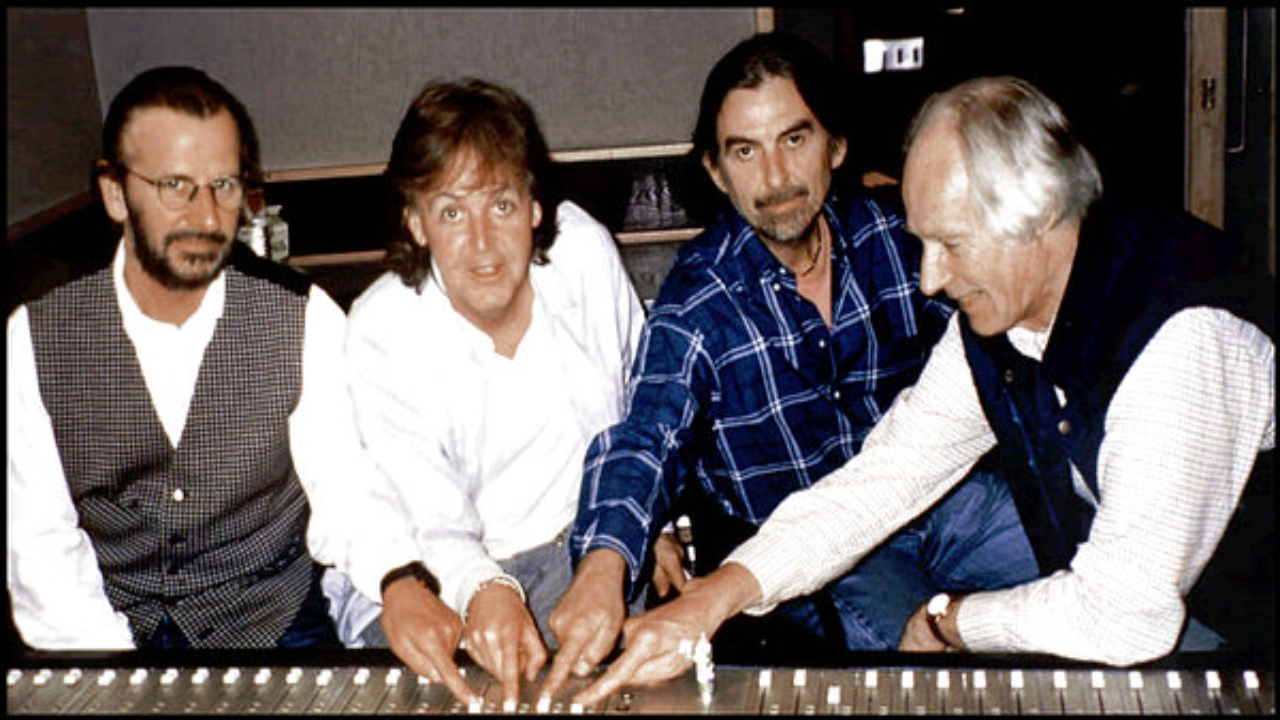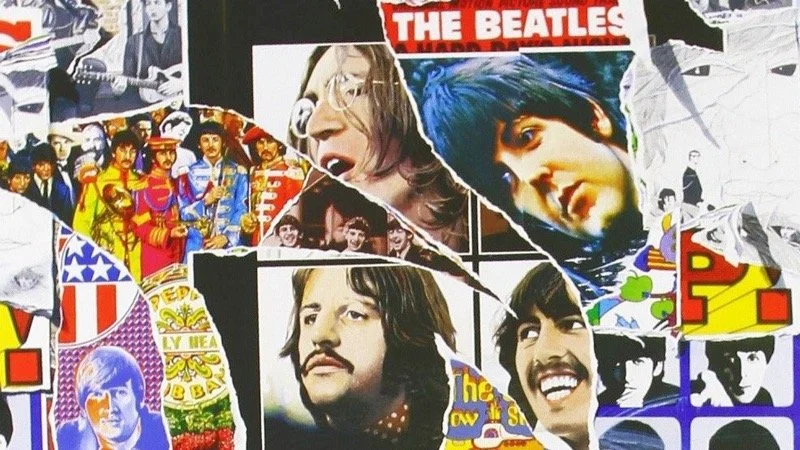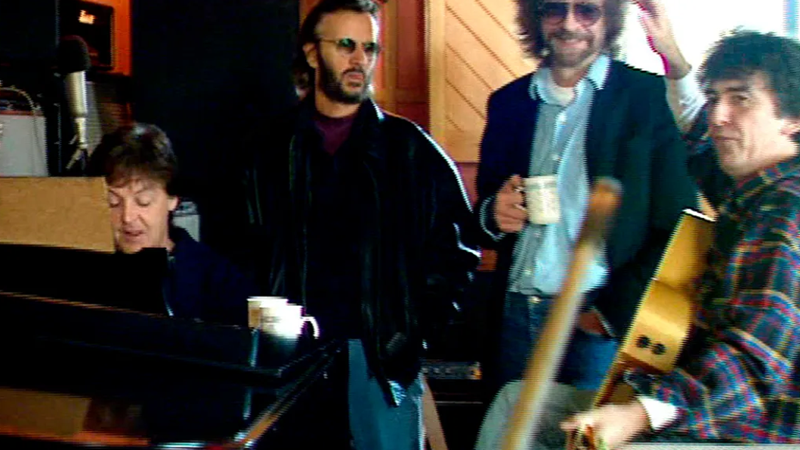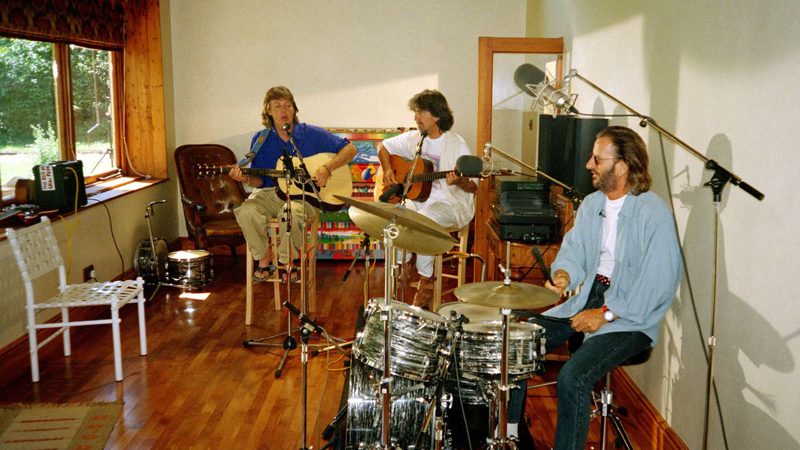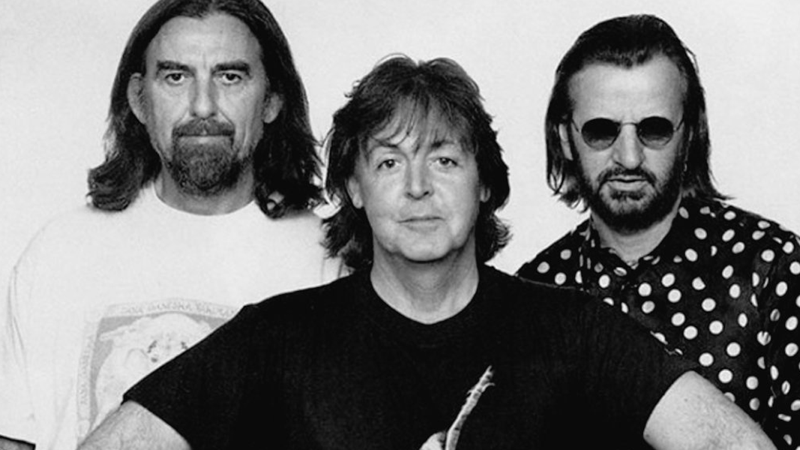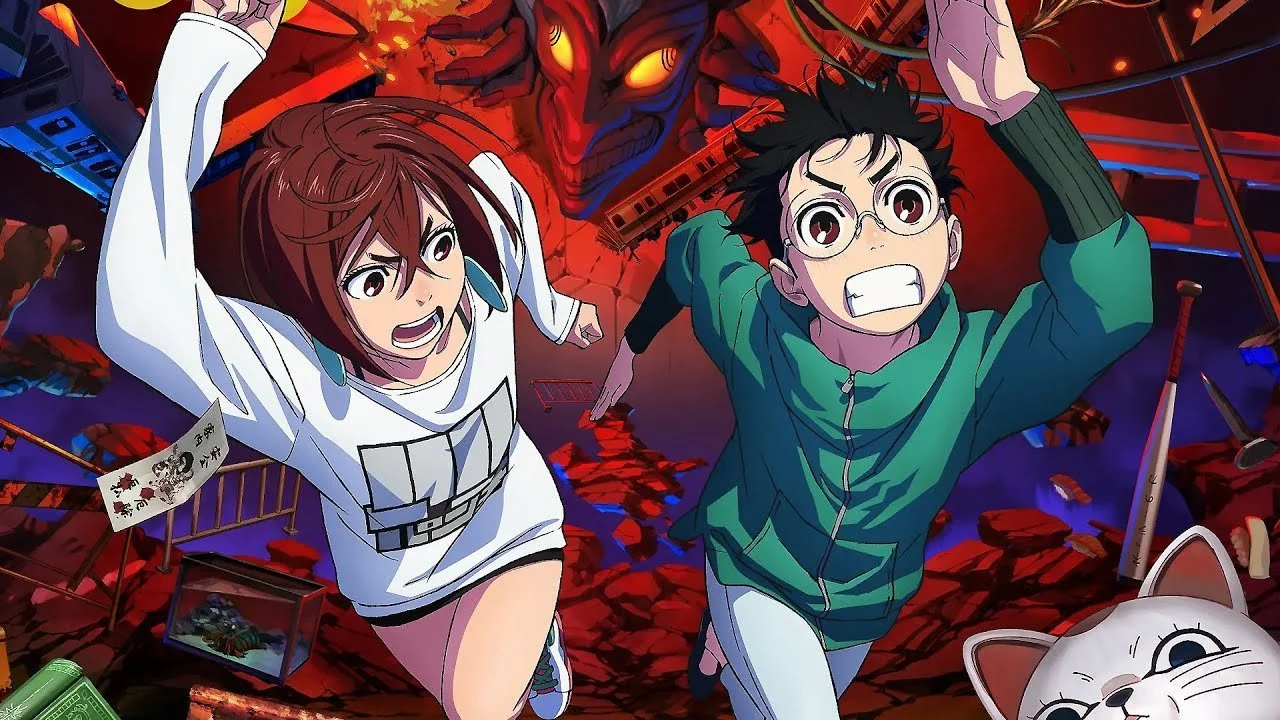How The Beatles Were "Reunited" In The 90s
Image Source: The Rip Post
The Beatles did more in their short time together than most bands would ever dream of, and their breakup has left a hole that has been hard to fill. Ever since 1970, the question has always been, “When will they get back together?” There were rumors, murmurs, and offers all throughout the 70s. The closest that decade got to a true Beatles reunion was when all four Beatles were present on Ringo Starr’s album Ringo, and the only time John Lennon and Paul McCartney ever sang together after the breakup was during a jam session in 1974. However, the four lads from Liverpool never played together again. With John Lennon’s assassination on December 8th, 1980, it seemed that all hope was lost for a Beatles reunion, or was it?
The death of John Lennon did not deter reunion efforts. In the mid-90s, Paul McCartney, George Harrison, and Ringo Starr reunited to work on The Beatles Anthology project. Though most of the work they did on the project related to the documentary mini-series, they did come together to release two new songs under The Beatles' name. How was that possible without John being present? Let’s dive into the time The Beatles reunited for one last time.
RELATED:
Image Source: IGN
The History Of The Beatles Anthology Project
The Beatles Anthology project began as early as 1970. Neil Aspinall, a longtime friend of The Beatles and then-current manager of Apple Corps, had compiled various interviews, television appearances, and concert footage of the group into a 90-minute film called The Long and Winding Road, and it was completed in 1971. However, The Beatles themselves were not involved at this point, and the project lay dormant until 1980 when John Lennon mentioned it in addition to a reunion concert during a legal deposition with the producers of the Broadway musical Beatlemania, stating “ I and the other three former Beatles have plans to stage a reunion concert.” Lennon had indeed planned to stage a reunion concert with the other three Beatles, and it was meant to cap off The Long and Winding Road. He was planning to go back to England shortly before he was murdered, but it was not to be. After, the project lay dormant and was resurrected in 1989, this time with direct involvement from the surviving Beatles. George Harrison did not like the project being named after a Paul McCartney song, so it was renamed The Beatles Anthology. Furthermore, the concert idea was replaced with new music.
Image Source: Consequence
New Beatles Music: The First In Nearly 30 Years
Initially, McCartney, Harrison, and Starr were planning to just create some incidental music for the six-part documentary, but it was soon decided that some new songs would be produced. McCartney and Harrison wrote the song “All For Love,” but it was soon decided that it just wasn’t the same without John Lennon. So, the three remaining Beatles reached out to Lennon’s widow Yoko Ono and asked if there was anything that John had left unfinished. Ono gave them cassette tapes of four songs: “Free As a Bird,” “Grow Old With Me,” “Now and Then,” and “Real Love.” Yoko took the occasion of Paul McCartney inducting John Lennon into the Rock and Roll Hall of Fame to hand over the tapes.
“It was all settled before then, I just used that occasion to hand over the tapes personally to Paul. I did not break up The Beatles, but I was there at the time, you know? Now I’m in a position where I could bring them back together and I would not want to hinder that. It was kind of a situation given to me by fate.” Yoko stated.
McCartney went to Yoko's home and listened to the tapes and was touched by them. However, he was initially wary of adding to these songs, stating to Yoko, “Don’t impose too many conditions on us, it’s really difficult to do this, spiritually. We don’t know, we may hate each other after two hours in the studio and just walk out. So don’t put any conditions, it’s tough enough. If it doesn’t work out, you can veto it.” However, when he said this same thing to George and Ringo, they were shocked, stating “What? What if we love it?” Tensions thankfully did not rise to the level in which the project had to be vetoed.
So, The “Threetles,” as they were dubbed in the press, went to work on these unfinished tracks. They passed on “Grow Old Along With Me” due to its presence on the album Milk and Honey and instead focused on “Free As a Bird,” “Real Love,” and “Now and Then,” starting with “Free As a Bird.” They initially wanted George Martin to produce the track, and while Martin was comfortable working on the archival recordings part of the project, he did not feel comfortable working on these new songs due to his deteriorating hearing. So, George Harrison suggested Jeff Lynne of the Electric Light Orchestra, who happily joined the project. Work began on “Free As a Bird” first. Before any new recording could be done, however, John’s tape had to be cleaned up and synchronized to a click track, as the late Beatle’s timekeeping was quite erratic. It was then transferred to a 48-track analog multitrack at Lynne’s Hollywood studio. Jeff Lynne had this to say regarding this process:
"It was very difficult, and one of the hardest jobs I’ve ever had to do, because of the nature of the source material; it was very primitive sounding, to say the least. I spent about a week at my own studio cleaning up both tracks on my computer, with a friend of mine, Marc Mann, who is a great engineer, musician and computer expert…Putting fresh music to it was the easy part! ‘Free As A Bird’, however, wasn’t a quarter as noisy as ‘Real Love’, and only a bit of EQ was needed to cure most problems.”
After the demo track was prepared for recording, it was transferred to McCartney’s studio in Sussex, with McCartney producing the track alongside Lyne. The three remaining Beatles, in order to deal with the absence of Lennon, decided to pretend that the slain Beatle was merely on holiday and had left the track for them to finish. This relieved a great amount of stress among them, as it allowed them “to be not too, ahh, the great sacred fallen hero,” as McCartney stated. With this elephant in the room dealt with, the magic was back as they went to work adding new lyrics, chords, and arrangements to this unfinished track. One of the most significant additions was a new middle eight written by McCartney. On the tape, John had laid out this section by starting with “Whatever happened to the life that we once knew” and followed it with a series of nonsensical adlibs. McCartney replaced the adlibs with his own lyrics. He described the process as being very similar to working with John back in the day, stating that this song was “like working on a record with John, as Lennon/McCartney/Harrison, because we all chipped in a bit on this one. George and I were vying for best lyric. That was more satisfying than just taking a John song, which was what we did for the second, ‘Real Love’. It worked out great but it wasn’t as much fun.”
Image Source: Steve Hoffman Forums
Lynne was especially ecstatic to be “in the inner sanctum” as he put it. Despite it being quite some time since they worked together as a band, it was like they had never broken up. When Paul and George added their backing vocals, Lynne described it as “all of a sudden it’s The Beatles again!” In between takes, the three of them would crack jokes and reminisce about old times, with Lynne waiting to record and say “OK, Let’s do a take,” but he was too busy laughing and smiling to do so. An interesting thing to note was that the song was recorded with mostly analog equipment in order to make it as authentic as possible. While Paul opted to use his five-string Wal bass instead of his trademark Hofner violin bass, Ringo opted to use his classic Ludwig kit. Harrison played two Fender Stratocasters and both McCartney and Harrison recorded acoustic guitar for the track. There were some tensions during the recording, however. One such argument mirrored one featured in the Let It Be film in which McCartney and Harrison argued over a guitar solo. McCartney wanted it to be a simple bluesy lick rather than a more melodic solo, stating “It should stay very Beatles. It shouldn't get to sound like me solo or George solo, or Ringo for that matter. It should sound like a Beatles song. So, the suggestion was made that George might play a simple, bluesy lick – rather than get too melodic.”
Though the environment within the studio was mostly positive, initial reactions to the news of this new Beatles track were mixed. McCartney recounts a story in which he encountered a customs officer when he was going through New York who was not pleased with the track, stating that he didn’t “consider it a Beatles project without John.” Paul initially ignored it but then chose to snap back at the man, saying “I don't care what you think – and it shows how much you know anyway, because John is fucking on it.” Despite some initial misgivings, the song performed well in the charts once released, reaching number 2 in the UK and number 6 in the US.
Work on “Real Love” was not as magical. Firstly, the actual demo had a 60-cycle hum that needed to be removed before any overdubs could be added. Lynne described this as the hardest part of recording the song, as he had to get rid of “the hiss and the mains hum” as well as the clicks present throughout the track. After this process, Lynne stated that “Putting fresh music to it was the easy part!” Despite this, it was not as enjoyable as working on “Free As a Bird,” as this song was in a more complete state than that song. McCartney said recording “Real Love” was more like being “‘sidemen’ to John” rather than producing a new Beatles track, but he still described it as “joyful” and that he thought they did a good job. Once again, McCartney opted not to use his iconic Hofner bass on this recording and instead used both an upright bass that was used by Elvis Presley’s bass player Bill Black on “Heartbreak Hotel” and a traditional Fender Jazz Bass.
Upon release, the song debuted at number four in the UK and number 30 in the US. Though it peaked at number 10 in the US, it did not move beyond number 4 reportedly due to BBC Radio 1’s refusal to air the track. McCartney had this to say regarding this decision:
Image Source: X (formerly Twitter)
"The Beatles don’t need our new single, ‘Real Love’, to be a hit. It’s not as if our careers depend on it. If Radio 1 feels that we should be banned now, it’s not exactly going to ruin us overnight. You can’t put an age limit on good music. It’s very heartening to know that, while the kindergarten kings of Radio 1 may think The Beatles are too old to come out to play, a lot of younger British bands don’t seem to share that view. I’m forever reading how bands like Oasis are openly crediting The Beatles as inspiration, and I’m pleased that I can hear The Beatles in a lot of the music around today. As Ringo said to me about all this, who needs Radio 1 when you’ve got all the independent stations?”
Ultimately, this was to be the last song credited to The Beatles. Work was started on “Now and Then,” but it was abandoned, as it to had a similar hum issue to “Real Love” and was even less complete than “Free As a Bird.” Harrison reportedly called the demo “rubbish,” and the project was abandoned, with a scrapped orchestral introduction to “Don’t Pass Me By” from The White Album titled “A Beginning” becoming the lead track on Anthology 3. McCartney, however, still wanted to complete the track and has reportedly been trying to do so for a long time, even after Harrison’s passing in 2001. This brings us to the present.
Image Source: X (formerly Twitter)
One Last Hurrah For The Fab Four?
With news of a new Beatles track coming later this year, speculation has abounded as to whether or not it was the long-teased “Now and Then.” Paul McCartney stated that this track was created with the help of artificial intelligence, leading to much outrage, with many thinking a fake “John” and “George” would be featured on the track, but McCartney clarified that this was not the case, and the technology was only used to clean up the track. It has not been officially revealed that the new track is “Now and Then,” but it seems to be very likely, as McCartney has stated his intention to finish the track for years. Though both Lennon and Harrison are no longer with us, the magic of The Beatles lives on, and fans will be able to experience this magic one last time, completing the story of The Beatles, and reuniting them just like they were in the 90s.
READ NEXT:
Sources: Beatles Bible, [1], [2], The Paul McCartney Project, Ultimate Classic Rock, Sound On Sound

